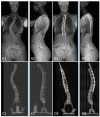Virtual Scoliosis Surgery Using a 3D-Printed Model Based on Biplanar Radiographs
- PMID: 36135015
- PMCID: PMC9495694
- DOI: 10.3390/bioengineering9090469
Virtual Scoliosis Surgery Using a 3D-Printed Model Based on Biplanar Radiographs
Abstract
The aim of this paper is to describe a protocol that simulates the spinal surgery undergone by adolescents with idiopathic scoliosis (AIS) by using a 3D-printed spine model. Patients with AIS underwent pre- and postoperative bi-planar low-dose X-rays from which a numerical 3D model of their spine was generated. The preoperative numerical spine model was subsequently 3D printed to virtually reproduce the spine surgery. Special consideration was given to the printing materials for the 3D-printed elements in order to reflect the radiopaque and mechanical properties of typical bones most accurately. Two patients with AIS were recruited and operated. During the virtual surgery, both pre- and postoperative images of the 3D-printed spine model were acquired. The proposed 3D-printing workflow used to create a realistic 3D-printed spine suitable for virtual surgery appears to be feasible and reliable. This method could be used for virtual-reality scoliosis surgery training incorporating 3D-printed models, and to test surgical instruments and implants.
Keywords: 3D printing; additive manufacturing; bi-planar X-rays; scoliosis; virtual surgery.
Conflict of interest statement
Authors J.S., P.D., C.A., Antonio Cebrian, B.A. are full time employees of the company EOS Imaging, an affiliated company of Alphatec Holdings, Inc. Author LT is a full-time employee of the company eCential Robotics.
Figures










References
-
- Wong R.M.Y., Wong P.Y., Liu C., Chung Y.L., Wong K.C., Tso C.Y., Chow S.K., Cheung W.H., Yung P.S., Chui C.S., et al. 3D printing in orthopaedic surgery: A scoping review of randomized controlled trials. Bone Jt. Res. 2021;10:807–819. doi: 10.1302/2046-3758.1012.BJR-2021-0288.R2. - DOI - PMC - PubMed
Grants and funding
LinkOut - more resources
Full Text Sources

